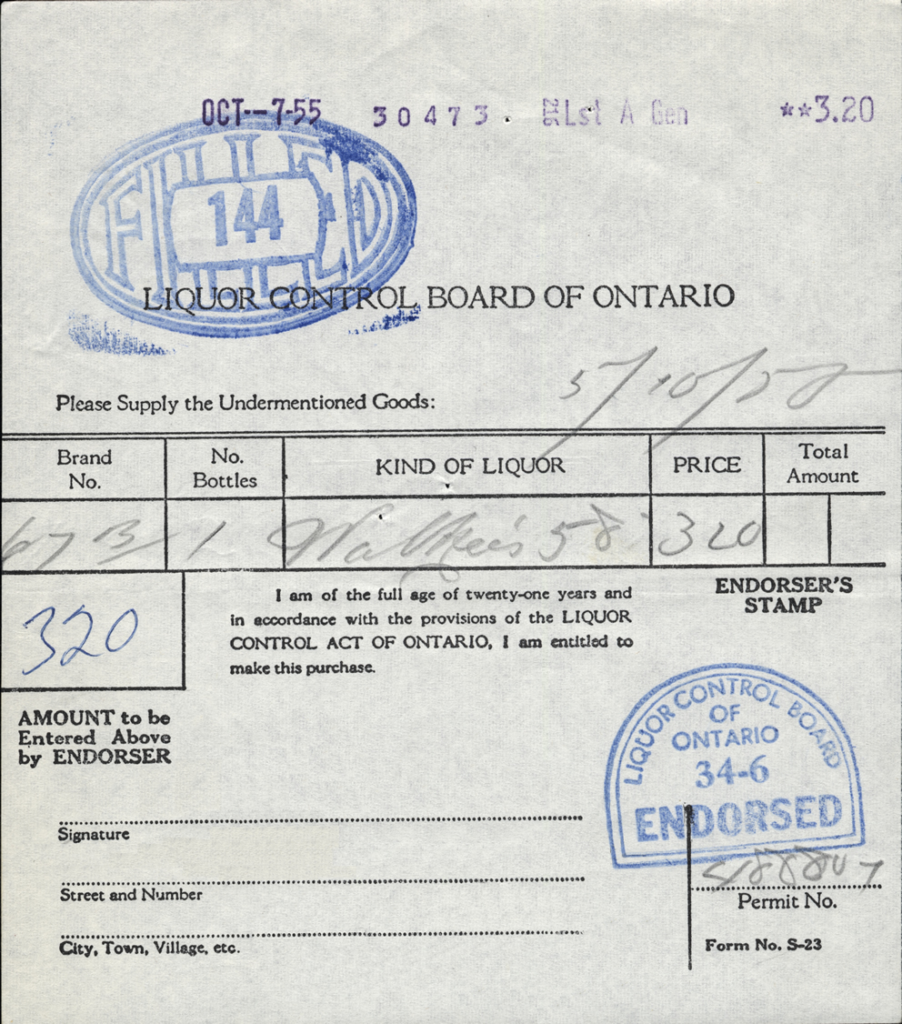The LCBO’s second piece of disciplinary technology was the “Purchase Order Form,” or “Customer’s Purchase Order Form” — LCBO Form S-23, also known as Form 19 in the early years (LCBO Vendor’s Instructions, 1927: 1) — which permittees had to fill out in the process of buying liquor (LCBO Circular no. 3245, 1942; Liquor Control Act1927, c.70, s.32.2(a)). The form contained a formal declaration of a request for liquor and was signed by the permit holder; it included the type of liquor requested, amounts, the date, and the individual’s permit number. The form represented the Board’s own permanent record of all purchases and sales in the province, especially in tracking the consumption of particular liquor types. Its long life lasted from 1927 until the 1970s, when the Board slowly phased out the use of Purchase Order forms in converting its stores to self-serve. The last store to undertake this change was the outlet in Kenora, which made the transition in the late 1970s.
The forms containing newly requested purchases were reviewed by store vendors or permit endorsers along with the purchaser’s liquor permit. If approved, the order would be filled. The original Purchase Order forms were stamped as “Endorsed” by the employee who made the sale, and stamped as “filled” by the employee who physically handed the purchaser his or her liquor. Ultimately the forms were to be checked to make sure that no serial numbers were missing and then “forwarded by Vendors each day for filing in the Permit Department” in Toronto, where they were reviewed “against Second copies” for instances of irregularities or overindulgence. In the early years Purchase Order forms were individually reviewed in Toronto — in 1932 over two hundred employees were required to undertake this detailed scrutiny (LCBO Vendor’s Instructions, 1927: 1); LCBO Annual Reports 1932-1933, 1933).

Based on these detailed and scrupulously applied records, both the actions of permit holders and LCBO staff fell under constant surveillance. Staff in particular had to constantly keep in mind the goal “of preventing possible irregular practices on the part of the purchasers” by paying “personal attention” to each sale (LCBO Circular no. 3377, 1943). In its formative years the Board expressed strongly to its employees that they had the “success of the law in their hands” and they were to be active in “preventing discredit falling upon the store system through immoderation or other wrongdoing by permit holders” (LCBO Circular no. 497, 1928; LCBO 1927: 3; see also LCBO Circular no. 382, 1928). In that regard the Purchase Order Form served the additional purpose of making possible the individualized surveillance of vendors at the local level — especially of those who were sometimes quite geographically remote (LCBO Manual 1951: 6). In addition to internal regulation the Board regularly offered its purchase records to local and provincial police as well as relief organizations — reconstructing purchase events through a Purchase Order Form’s recorded permit number, endorsed stamp number, filled stamp number, cash register number, and register tape number (LCBO Circular no. 169, 1927, no. 625, 1929, no. 1879, 1937, no. 1952, 1938; Letter from Supervisor of Stores, Dec. 13, 1955).
Note: The LCBO’s Purchase Order Form recorded individually numbered “Endorsed” and “Filled” stamps, coupled with cashier numbers and purchaser’s permit numbers; it not only created a detailed purchase record but also captured the specific role that each employee played in the delivery of the purchase. Nearly identical forms were required for beer purchases from breweries (LCBO Form S-25), mail-order purchases (LCBO Form S-32), and agent purchase orders (LCBO Form. S-24). Source: LCBO Circular no. 653,1929; LCBO Handbook 1951: 58).
<< Making a Purchase Purchase Order Form “Endorsed” and “Filled” Stamps
Reviewing Purchases Purchase Records and Police >>
